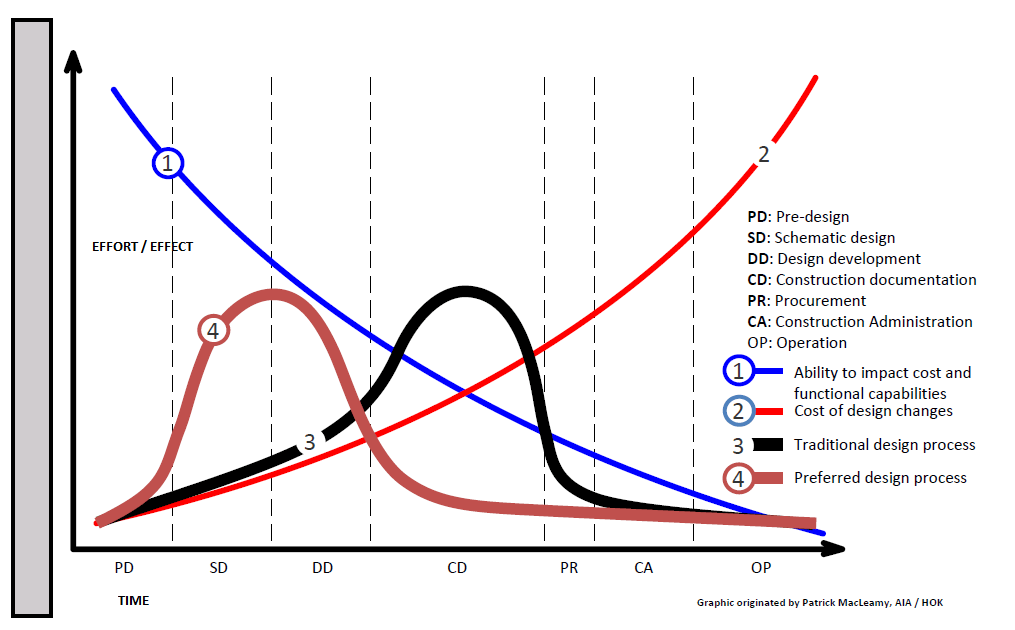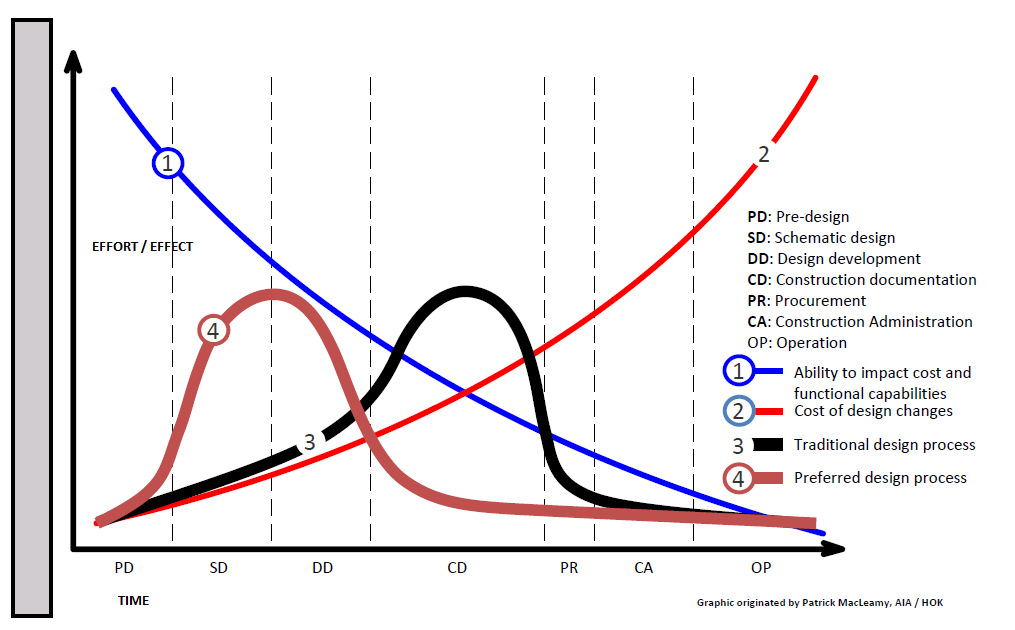Have you heard this announcement? “Does a butterfly flapping its wings in New Mexico cause a hurricane in China?”
It's called the butterfly effect.
In fact, this butterfly example is a bit of an exaggeration, but the underlying principle is not; Small changes can have big consequences. And these major consequences become impossible to predict over time. Now map this concept to construction projects and our traditional waterfall planning method.
What researchers have noted is that carrying out 100% of the design and planning effort before we begin construction is insufficient.
Due to the size and duration of construction projects, we are repeatedly caught by the butterfly effect.
Defensive design
In 2004, Patrick MacLeamy produced a set of curves that would firmly solidify the problems with our traditional design-build approach. It's called the MacLeamy curve. 
The MacLeamy curve draws our attention to the fact that much of the design of a typical construction project occurs at a time when design changes are costly. In this graph, this is where the red and blue lines intersect.
MacLeamy explains in the video below that designers are doing what he calls “defensive design”:
A new approach was needed to shift the design work (and the curve) back to the early stages of the project, when changes are not as costly and the ability to impact project outcomes is also high. This is where lean construction comes in!
What is lean construction and why is it important
It's been around since the late 1990s, but you may have never heard of lean construction. Perhaps inspired by the trend in software development to design and code software in incremental bursts, lean construction developers created a method for producing a predictable workflow on construction projects, taking ideas from Toyota's Production Line System.
Lean construction is a new iterative construction approach. Planning, design, and construction are done in smaller chunks, one at a time, with a detailed approach called the “Last Planner Method.”
Instead of carrying out all the planning and design in advance and then moving on to construction (what we call the Waterfall Method of project management), in Lean the work is planned, designed and scheduled weekly, incrementally.
Lean planning in construction is based on a commitment to deliver a certain element of work and time per day, starting at the end and working back to the beginning. Lean construction is all about collaboration. It's a real wake-up call to the traditional approach to construction, where owners set the requirements and contractors go out and build, only discussing when there are problems or setbacks.
Instead, we invite all parties to the table to plan, design, estimate, budget and optimize. All interested parties collaborate and plan together; owner, contractor, subcontractors, designers, engineers, programmers, cost engineers, etc.
The team will often prototype a design rather than go ahead and build. Prototyping provides us with a visual and functional model that we test and evaluate. Today's advanced BIM software tools allow us to quickly prototype projects and analyze them virtually.
Instead of pricing a project, the team designs according to the allocated budget. Cost and labor optimization is one of the biggest benefits of lean construction. Studies suggest that adopting lean construction can save up to 30% of the project cost.
Collectively, the team will present opportunities, suggestions, brainstorm with the owner, build scale models, mockups, and engage with end users and customers to gather feedback.
What are the basic principles of Lean?
So let's dig a little deeper into what constitutes lean construction. One definition cites lean construction as “a work philosophy based on continually delivering better value to customers while increasing business profitability and competitiveness.”
Essentially, lean manufacturing is a culture and should be employee-focused. Any company that adopts Lean principles will rely on its people to identify hidden issues and deal with them, reducing waste, evaluating working practices and looking for ways to work more efficiently. This must be done through teamwork, where workers can unite around a single purpose and everyone works towards the same objective identified by the company.
In this regard, the idea of Lean cannot simply be dismissed from the workforce. There needs to be buy-in from employees who understand why they are adopting this approach and the benefits it can provide.
The idea of Lean, first launched by Toyota, is to provide a clean, safe and efficient work environment. The philosophy is divided into 5 S's. In English, this is usually translated as classify, put in order, sweep up, standardize, sustain. Let's look at this in detail:
- Organize – Get rid of anything in excess of requirements, such as tools, documents or materials
- Put it in order – Establish a place for everything and store each object in that specific place. Employees must have easy access to everything they need.
- Sweeping – This essentially involves ensuring that the workplace is kept tidy
- Standardize – Work practices must be clearly defined and consistent at all levels.
- Sustain – Once you establish a process that follows these, the idea is that you sustain them.
What is the lean philosophy?
So what's the best way to adopt a lean construction approach? For starters, you need someone in the company who can act as an advocate for implementing change. Implementing new ideas can often be met with great resistance, especially in an industry like construction where there is a built-in resistance to change and new concepts.
So, ideally, the individual needs to be someone with the strength of character to persuade people of the benefits of a Lean approach. And, of course, whoever is leading the change needs to have the full support of management.
To unite people under the same cause, you need to convince them of the reasons why you are adopting Lean principles. In this regard, ideally, it is good to identify a triggering reason to shake things up. Due to the general nature of construction, a crisis is often never very close. So if you're thinking about Lean, the next time a major problem arises or a project fails, this might be an opportune time to strike and convince your team that a new approach is needed.
Once you decide to take the plunge, it's important to start with a highly visible activity and ensure immediate results. The problem you want to avoid is simply trying to cut costs or get people to do things faster. This will certainly create a negative reaction among employees and will not get things off to a good start.
Find it here: Ten benefits of prefabricated construction
Once you get things off the ground, it's important to keep the momentum going and broaden the scope to bring people with you. This is how Lean will work successfully, as it should ideally bring new opportunities for continuous improvement.
Lean is also about understanding in greater depth what the customer demands. So it's not just about what to build, but also the reasons behind it. If you can understand and appreciate this, it will help your customer relationships.
Ultimately, adopting lean construction principles will not be for everyone. It might not be a great fit for your business or the idea just isn't right for your business as you can't see that it will be enough. Or maybe your business is already as efficient and lean as you need it to be – in which case, well and good as you were.
But for many construction companies, as can be seen from numerous examples, productivity and efficiency are still concepts that elude them. In this regard, trying to adopt at least some of the principles of Lean could make a significant difference.
There's a huge amount of information and advice out there, so there's no better time like this to give it a try. For some contractors, it can even be the difference between survival and failure.
Lean construction focuses on reducing waste
A major focus of Lean Construction and Lean Planning is to reduce waste in Construction. Research estimates that only 40% of the entire budget of a typical construction project is spent on value-added activities, while the remaining 60% of the budget is non-value-added actions, such as:
- Waiting time (materials, approval, previous work, etc.
- Inventory stock
- Defect correction
- Overproduction (activities outside the Critical Path)
- Inefficient transportation
- Bad planning
The collaborative nature of Lean Construction makes it much easier to maximize value and eliminate waste.
One of the principles of Lean Construction is called “Value Stream”: the team aims to adopt the most effective process, achieved by the minimum number of value-added steps.
What does a lean construction schedule look like?
In a Lean Construction project, we often build a simple milestone schedule for the part of the work we are focused on. This is different from traditional CPM schedules.
Much of the planning and scheduling in Lean Construction is called “pull planning”. In pull planning, we plan backwards, starting with the end in mind and setting steps backwards incrementally.

In pull planning, key milestones are broken down into 3- or 6-week advance timelines, keeping the focus on the work the team has at the moment.
We asked:
- What do we need to be ready?
- What decisions need to be made?
- What materials will allow the work to happen?
The 6-week schedule is planned by the people who will carry out the work – the contractors and tradespeople.
When scheduling, team members respond:
- Yes, I can do this
- No, I can't do that, because… so that becomes a new restriction.
Then the team works to remove this restriction.
Conclusion
How do you implement Lean Construction? There are several ways. But get ready to turn your familiar construction routine upside down. Once you embrace it, Lean Construction is not just how you work, but how you live. Start by getting involved in Communities of Practice. Plan a Lean Construction project site visit, attend presentations or a bootcamp. Some even offer simulations on how to build a Lego with the Lean methodology.
However, if you decide to start with Lean Construction, be sure to approach it with an open mind. As inventor/engineer Charles Kettering said: “There are unlimited opportunities in every industry. Where there is an open mind, there will always be a border.”

